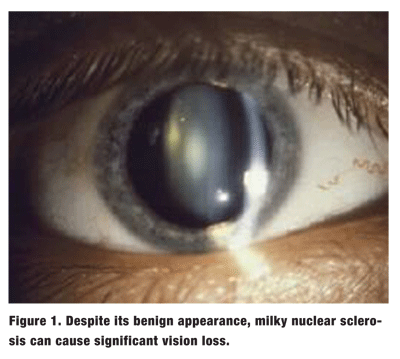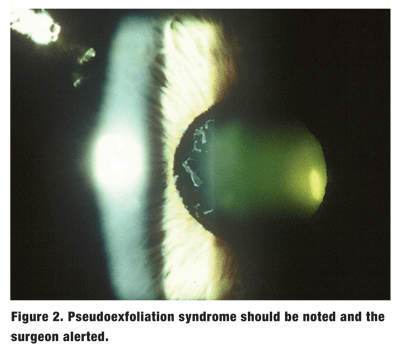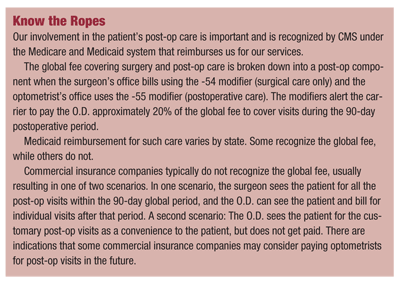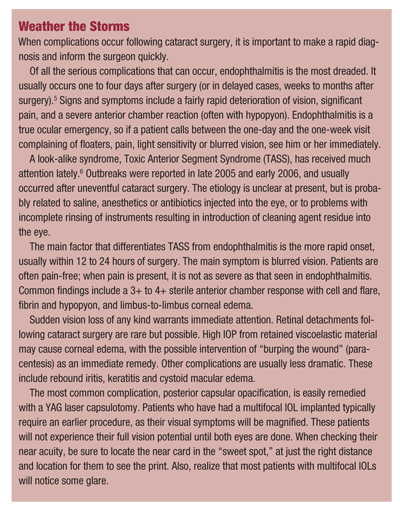The days of sending a patient to a cataract surgeon to determine if the cataract is ripe are a distant memory for some O.D.s and unheard of for many others. In this era of primary-care optometry, we are, or should be, the captain of the patients ship. We must steer patients to our surgeons of choice and then back to our practices for appropriate follow-up care.
For optometrists, the trick is to identify skilled surgeons who achieve consistent results and who are accessible, down-to-earth, caring toward patients and optometry-friendly. It is well worth the time spent to research those who meet these criteria, as it will ultimately enhance the patients surgical experience and outcome. Even if you think you have an ideal relationship with your surgeon, re-evaluating it periodically is to everyones advantage.
This article will review the latest thinking in pre- and postoperative care and the important role that optometrists play in this process. The huge wave of baby boomers over the next 15 years will push urologists, geriatricians and other physicians into overdrive, said Los Angeles Times Lisa Girion. Their cloudy eyes alone, one study found, could boost the demand for cataract surgery by 47%.1 Our responsibility in caring for these patients will become even greater than it is today.
Nose to the Wind
Good decisions are based on good information, so the cataract evaluation starts with a thorough history. This must include a chief complaint that relates to a functional impairment in daily living. We can no longer simply state that the patient has had vision loss for six months. For Medicare and other payers to cover the procedure, we must document a specific disability, such as difficulty driving due to glare at night, cant read small print or problems seeing the sports ticker on the bottom of the TV screen.
These complaints must be accompanied by appropriate and corresponding acuity testing, such as a glare test for patients who complain of glare and a near acuity for patients with reading complaints. The most important question to answer, no matter what the degree of lens opacification, is whether the patient is bothered enough by his or her vision to consider surgery. If the answer is no, re-assess the patient in six months. A premature referral for surgery could lead to a cancelled case and a very angry patient.
Assume nothing when you take the ocular and medical history. If something doesnt add up, ask more questions.
There are many more issues to discuss with patients than there were just 10 years ago. In the past, we simply asked cataract patients if their vision was bothering them and if they would like to see better. Today, however, you need to consider such things as whether:
Astigmatic patients are candidates for a limbal relaxing incision (LRI) or the recently approved AcrySof Toric Lens (Alcon), which the Centers for Medicare and Medicaid Services (CMS) just ruled eligible for balanced billing.
Monovision contact lens wearers would like to continue with this type of correction.
A multifocal intraocular lens (IOL) is appropriate for patients who no longer wish to wear glasses? Today, there are many more factors to consider than there were just 10 or 20 years ago!
In order to be complete, you should ask about a history of trauma, glaucoma, retinal or refractive surgeries, and current or prior contact lens wear. Contact lens patients should discontinue lens wear for a week or two prior to surgery or longer with gas permeable lenses. To ensure accurate keratometry (K) readings and an accurate IOL power calculation, the cornea must be as close to its normal shape as possible.
Similarly, an increasing number of refractive surgery patients now present with cataracts. Anyone who has had RK, PRK or LASIK requires a careful pre-op evaluation in which central Ks are entered into a formula to calculate the lens power as accurately as possible. However, you need to warn these patients in advance that the final refractive power of the eye could still be incorrect. All these issues, including the type of IOL to be implanted, should be discussed well in advance of the actual surgery date.
The medical history is critical. The individuals health must be good enough to undergo outpatient surgery. Any time we identify poorly controlled diabetics, hypertensives or recent heart patients, we must bring that to the attention of the patients general practitioner and the cataract surgeon.
A history of medications is equally important. Diligent attention must be paid to the use of drugs such as Flomax (tamsulosin, Boehringer Ingelheim) and, to a lesser extent, other alpha-adrenergic blockers such as Hytrin (terazosin hydrochloride, Abbott) and Cardura (doxazosin mesylate, Pfizer) that can adversely affect surgical success. These medications, used for the treatment of hypertension and more commonly for benign prostatic hyperplasia (BPH), or enlarged prostate, can lead to intraoperative floppy iris syndrome (IFIS).2 This syndrome can result in pupil constriction during cataract surgery.
Between the Devil and the
The history is important, but dont succumb to the doldrums when it comes to the eye exam itself. The lens should be carefully evaluated and the level of opacity recorded; but be sure that what you see in the lens matches the reduced acuity. A lens that shows moderate brunescent nuclear sclerosis should have moderate (20/50-20/100) vision loss and a moderately reduced view of the fundus.
If your view in does not match their view out, other reasons for acuity loss  must be explored. Exceptions can occur with a posterior subcapsular cataract, where the acuity is sometimes better than predicted based on your view into the eye. Milky nuclear sclerosis,3 often seen in younger patients with a history of rapidly changing prescriptions, can be deceiving as well, resulting in unnecessary referrals to retinal or neurology specialists. Many gloss over the opacity as too clear to cause significant vision loss, but the classic appearance (see figure 1) along with bowing of the fundus lens beam confirm that this type of clouding is in fact responsible for the reduced vision.
must be explored. Exceptions can occur with a posterior subcapsular cataract, where the acuity is sometimes better than predicted based on your view into the eye. Milky nuclear sclerosis,3 often seen in younger patients with a history of rapidly changing prescriptions, can be deceiving as well, resulting in unnecessary referrals to retinal or neurology specialists. Many gloss over the opacity as too clear to cause significant vision loss, but the classic appearance (see figure 1) along with bowing of the fundus lens beam confirm that this type of clouding is in fact responsible for the reduced vision.
Awareness of existing conditions other than the cataract is critical to a good outcome. These include keratoconus, epiretinal membranes and glaucomaall of which may contribute to the vision loss. Cataract surgery may still be warranted, but the patient should clearly understand that the visual result might not be 20/20.
Other ocular conditions can affect both the surgical and visual outcomes and must be brought to the attention of the surgeon. Guttata can lead to possible corneal decompensation after cataract surgery. Pseudoexfoliation syndrome can be associated with small pupils, weak zonules and ensuing complications (figure 2).4 Capsular tension rings, iris hooks and viscoelastics can all be used  to maximize pupil size and stabilize the lens.
to maximize pupil size and stabilize the lens.
Also note those patients who have nystagmus or head tremors and those who are overly sensitive to the slit lamp or BIO lights; they may require a retrobulbar block. Your heads-up to the surgeon can make for smoother sailing.
Batten Down the Hatches
Once you determine that your patient has a cataract, its time to schedule surgery. Dont leave anything to chance. By setting up surgery for your patient, you provide a service that makes your practice stand outand ensures that the patient will go to your preferred surgeon.
Be sure to convey all pertinent patient information to the surgeon in writing, and keep copies in the patients chart. Speak to the surgeon directly in complex cases, such as those that involve a prior LASIK patient or a concurrent retinal or optic nerve condition.
Once you schedule the surgery, stay involved in the patients care, including the day of surgery. A call from your office in which you check on your patient and confirm the one-day post-op visit, is an inexpensive marketing tool and a much appreciated gesture.
Better yet, consider occasionally scheduling yourself and perhaps even key employees to attend surgery with several of your patients. This lets you see firsthand what your patients experience so that you can advise future patients on what to expect. Second, you and your staff will get to know the staff at the ambulatory surgical center, allowing for easier communication when issues arise.
Plus, you can scrub in with the surgeon and get to observe him or her. You will learn a lot about the surgeons personality, surgical skill, time it takes to complete a case, and how he or she behaves under pressure. If the average length of each case lasts 35 minutes and the surgeon yells at the scrub techs, its time to find another surgeon.
Most importantly, by being there for the live surgery, you will learn about new techniques, instruments or medications that the surgeon uses and the surgeons desired post-op regimen. You can then communicate this information to patients first hand. Your patients will likely be grateful when you take the time to assist them on surgery day. This will pay big dividends as the word gets out that you are actively involved in all aspects of their vision, medical and surgical eye care.

Stay on Course
Optometric involvement in post-operative care is now commonplace. Medicare recognizes it, and so do most progressive surgeons. If some of our medical colleagues and their state and national organizations had their way, however, they would entirely eliminate our involvement in comanagement. If this is the case, why should we fight to keep it, and does it provide the best care for our patients? For the answers to these questions, we should turn to those very patients and the many ophthalmologists in this country who are very comfortable with the way the current system of care has evolved.
When offered the choice of whom they would like to see post-operatively, many patients choose their primary care doctor of optometry. The location may be more convenient, but more importantly, they probably know their O.D. much better than the surgeon, since they have been seeing him/her for many years. You are their doctor, and they trust that you will take care of them.
As with any surgery, complications may occur, and we expect the surgeon will be available to see these patients when needed. However, most high-volume surgeons who are comfortable with their results are also extremely comfortable with the optometrist handling all but the most complicated post-op scenarios. As long as communication exists between the two professionals, the patient will be well served. (See Weather the Storms.)
Be sure that patients can reach you any time, even if that means carrying a pager or making your cell phone number available. A recording on your answering machine that states, Office hours are 9 to 5, and, If this is an eye emergency go to your local emergency room, not only makes you inaccessible in case of an emergency; it can set you up for a malpractice suit as well.

As new techniques, medication regimens and even complications develop, we must stay on top of these trends so that we can provide the best care. Many surgeons now routinely use NSAIDs before and after the procedure to minimize the chance of cystoid macular edema (CME). New torsional handpieces make phacoemulsification even easier, and IOL options are expanding rapidly. Multifocal and toric IOLs have blurred the line between cataract and refractive surgery.
Many O.D.s are now involved in the one-day post-op cataract visit. The same things that we check on subsequent visits at one or four weeks should be checked at this visit as well. Visual acuity should be reasonable, usually between 20/20 to 20/50 depending on the clarity of the cornea and any uncorrected cylinder. The VA should improve with each visit. Also, note and grade cells and flare, examine the wound and measure intraocular pressure. A significant amount of cell and flare, corneal edema, or increased IOP could signal a problem that you should communicate immediately to the surgeon.
Ready About
With these thoughts in mind, it is time for all of us to take control of the rudder and help our patients navigate smoothly through their cataract experience. By taking a thorough history, performing a meticulous exam, and carefully documenting the patients health, we are well on our way to gathering the information we need to offer sound advice.
By staying informed about the latest technologies and sharing them with patientseven though it may take a little more timewe are sending a clear signal that we are cutting-edge providers. By carefully choosing a surgeon and maintaining good communication with him or her (and the surgeons staff) from the first scheduling phone call to the last post-op visit, we improve the level of care for our patients.
Being proactive and involved in every aspect of your patients care is what this journey is all about. The rewards are great. Is your practice ship shape?
1. Lisa Girion, Needs of Patients Outpace Doctors.
2. Chang DF, Campbell JR. Intraoperative floppy iris syndrome associated with tamsulosin. J Cataract Refract Surg 2005 Apr;31(4):664-73.
3. Ajamian P. Pre- and Post Operative Care of the Cataract Patient. Butterworth-Heinemann, 1993.
4. Brown, R. Pseudoexfoliation: A Double Challenge EyeWorld, Supplement October 2005.
5. Quinn CJ, Insinga JF. What can go wrong with cataract surgery? Rev Optom 2001 Jun;138(6):85-98.
6. Mamalis N et al. Toxic Anterior Segment Syndrome. Supplement to Ophthalmology Times, October 15, 2006.

